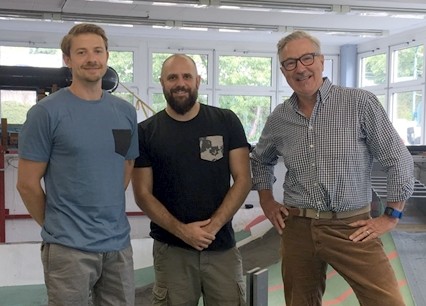- Alexander von Humbold-Stiftung prämiert Konzept zur Vernetzung der Forscher-Alumni
- Forscher-Alumni im "Querschnitt 5/2016"
- Forscher-Alumni im "Querschnitt 4/2017"
- Forscher-Alumni im "Querschnitt 1/2018"
- Forscher-Alumni im "Querschnitt 2/2018"
- Forscher-Alumni im "Querschnitt 3/2018"
- Forscher-Alumni im "Querschnitt 1/2019"
- Forscher-Alumni im "Querschnitt 2/2019"
- Forscher-Alumni im "Querschnitt 3/2019"
- Forscher-Alumni im "Querschnitt 1/2020"
- Forscher-Alumni im "Querschnitt 2/2020"
Asst. Prof. Dr.-Ing. Thomas Wahl - Prof. Dr.-Ing. Jürgen Jensen
How can the world adapt to floods, storm surges and rising sea levels? Siegener researchers work with the University of Central Florida to find out.
Unlike most of our Research Alumni, Prof. Dr.-Ing. Thomas Wahl was born and raised in Siegen. After completing his degree in civil engineering, he continued to receive his PhD at the University of Siegen’s Research Institute for Water and Environment (in German: FWU), which is led by Prof. Dr.-Ing. Jensen. After his PhD, Prof. Dr.-Ing. Wahl received a post-doctoral fellowship through the DAAD (German Academic Exchange Service), which allowed him to continue his research at the University of South Florida in St. Petersburg. Afterwards he was a Marie Sklodowska Curie fellow sponsored by the European Union to work at the University of Southampton, UK. After one year he returned to Florida to take on a position as Assistant Professor for Coastal Risks and Engineering at the University of Central Florida (UCF) in Orlando. Since moving to Florida, he has facilitated international cooperation with different institutions, including with his former colleagues in Siegen, Prof. Dr.-Ing. Jensen and Dr.-Ing. Arns, who works at the FWU as a senior researcher for coastal extremes.
The research conducted by Prof. Dr.-Ing. Wahl, Prof. Dr.-Ing. Jensen and Dr.-Ing. Arns is a mixture between coastal engineering and coastal oceanography. They study changes in sea level, extreme weather patterns, such as storm surges and the associated flooding impacts, in order to develop strategies to adapt to and mitigate these effects. The different locations of Siegen and Orlando mean that their focuses are of course slightly different; research Siegen is mostly (but not totally) concentrated on the North and Baltic seas, as well as inland river flooding, whereas as Florida is completely surrounded by the ocean, the Gulf of Mexico in the West, and the Atlantic in the East. And while Florida is at high risk from being affected by hurricanes (as happened last year when Irma devastated large parts of the State), the bigger risk for northern Europe are strong winter storms. Despite these differences, many of the methods developed by both institutions are applicable for many different coastal regions across the world.
Coastal research is becoming increasingly important because of the impacts of climate change, which includes rising sea levels, and an increased risk of storm surge flooding. However, the political climate in America can make it more difficult for Prof. Dr.-Ing. Wahl to highlight climate change when writing research proposals, since it’s still debated (by some) whether it is caused by human activity. But the data showing rising sea levels and the increased impacts from flooding is undeniable. For this reason Prof. Dr.-Ing. Wahl is able to work around this issue by focussing upon the tangible impacts, which are already making themselves known across the world. For example, cities like Miami or Washington DC experience minor flooding up to 50 times per year (or even more), causing massive amount of disruption for its residents.
There are different ways to adapt to sea level rise and storm surge risk, one is to defend the coastline, which is more popular in Europe; in Germany they are building dykes and dunes across the Baltic and North Sea coastlines. These solutions are not feasible in Florida because of the different geology. If they were to build a dyke, then water would come through underneath, so instead in some places they build very deep sea walls. Another important method used in Florida is beach nourishment, where they bring back sand to the beaches which is lost to erosion during storms. However, beach nourishment is very expensive and has to happen more frequently as sea levels continue to rise. “We are trying to maintain and restore wetlands, oyster and coral reefs which serve as wave breakers, dissipating some of the storm surge and wave energy that would otherwise directly affect the coast.
In many places, defending the entire coastline is not possible, so it is also necessary to talk about managed realignment, where you allow water to reclaim certain areas. Buyouts are becoming a tool in the United States after hurricanes, where the government buys people’s property to relocate them and not rebuild in areas that were repeatedly affected by storms and flooding. After looking at the cost benefit analyses for certain areas it becomes clear that maintaining them against storms and hurricanes is not always the best option. However, there are cities, such as Miami, where there is so much expensive infrastructure at risk, that installing defences is still much cheaper. To do this they are installing pumps and flood gates in certain areas, to reduce the impacts from flooding during high tides and storm surges.
Since coming to Siegen in 1991, Prof. Dr.-Ing. Jensen has worked to establish excellence in the field of sea level and climate change research, and helped it to become a prominent part of the civil engineering course of study. He is very proud to see that in the latest report from the International Panel on Climate Change, the key report on climate related issues, nearly 1% of the citations in the sea level chapter came from people who were educated in Siegen. They have also helped to establish a School of Marine Engineering in Namibia. The FWU has also made its impact on the City of Siegen, the new Siegplatte (the promenade along the river Sieg) was developed within their institute. He credits much of this success to close collaboration, both within the institute itself and with numerous international partners around the world.
Both Siegen and UCF recognise the necessity for interdisciplinary work, both are in the process of establishing centers for coastal research which bring together people from different backgrounds, such as engineers, scientists, economists and biologists, in order to investigate the different negative impacts to coastal environments, and develop solutions to adapt to changing circumstances. These centers also provide an opportunity to bring researchers from all across the world together to engage in coastal research. Different perspectives are especially important because at the coast, there are competing interests that have to be considered when planning for the future. For example, an engineer might suggest building a wall to protect the coastline, but someone with a background in biology would foresee a negative impact upon surrounding wildlife, a compromise between these different perspectives must be found.
When asked about their view of Siegen, Prof. Dr.-Ing. Wahl, Prof. Dr.-Ing. Jensen and Dr.-Ing. Arns all agree that Siegen is much improved compared to previous years. Siegen, which previously felt more like a rather large town, is becoming to feel more like a city, and a more attractive place to live and work. Throughout his recent visit to Siegen, Prof. Dr.-Ing. Wahl has spent time discussing ideas for joint publications between UCF and FWU. They were able to receive some money from the DAAD, which allowed students to come to Florida and work with Prof. Dr.-Ing. Wahl. Prof. Dr.-Ing. Jensen and Dr.-Ing. Arns have also been able to visit and learn about their approach to coastal research. The ocean is a precious resource shared by all of humanity, and is integral to the earth’s environmental integrity. It therefore needs cooperation between different research institutions around the world for us to truly understand it.
This article is based on an interview with Asst. Prof. Dr.-Ing. Thomas Wahl and Prof. Dr.-Ing. Jürgen Jensen and was written by Benjamin Wrigley.






